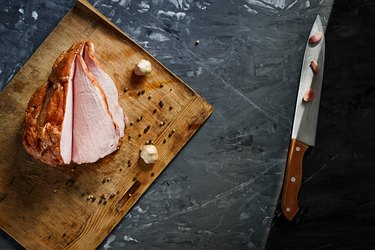
Hams include some of the most legendary of all cured meat. Whether wet-cured or dry, smoked or unsmoked, the rich flavor of a good ham always comes through. However, some cooks struggle to achieve a moist, delicate, melt-in-your-mouth texture in their baked ham dinners.
Understanding a few basics can make it much easier to get the finished product you are looking for.
Video of the Day
Video of the Day
Read more: Is Pork Better Than Beef?
Know the Ham Basics
When a piece of pork is cured to make ham, it goes through both chemical and physical changes. Osmosis draws salt and the other curing ingredients into the muscle cells of the pork, where it causes the protein molecules to contract. This is why an uncooked ham has a firmer texture than raw pork roast.
Because it's dense, ham requires long, slow cooking to become perfectly tender. It also must be protected from drying out during the cooking process.
According to the USDA, a 3-ounce serving of cooked ham provides:
- 178 calories
- 25 grams of protein
- 8 grams of total fat
- 2.8 grams of saturated fat
Fall-Apart Ham in Oven
Cooking any meat at high temperature causes its protein molecules to shrink and toughen. On a tender steak that is only on the grill for a few minutes, this isn't a problem. However, making a ham extra tender requires long, slow cooking.
This creates time for fat to render out of the ham and for its connective tissues to melt into natural gelatin. This is what lubricates the muscle fibers and creates a moist, tender impression in the mouth. This slow cooking can take place either in the oven or in a slow cooker, as described by PennState Extension.
Slow-Cooker Ham
A full-sized ham is too large for all but the biggest of slow cookers. However, it's also too big for most families. The smaller ham portions available at most butchers and supermarkets would fit easily into a 6- or 7-quart cooker.
Trim the ham of any excess fat, leaving approximately 1/4 inch to help prevent the ham from drying out. Glaze it if you wish, then place the ham in a preheated slow cooker with a 1/4 cup of water, white wine or cider. The liquid helps create steam in the slow cooker, preserving the moisture in your slow-cooker ham.
Read more: How to Make Oven-Baked Boneless Pork Chops
Slow Cook Ham in Oven
The same effect can be created if you slow cook ham in oven. Try cooking ham at 250 degrees Fahrenheit for a large size or 300 F for a small one, and pour a 1/2 cup of boiling water into the bottom of your roaster to provide steam.
Alternatively, slide your ham into the same type of roasting bag used for a turkey. This also keeps the ham moist as it bakes. Glaze the ham and cook it slowly until its internal temperature reaches 160 F — the minimum safe temperature for consumption of your baked ham dinner, according to the USDA Food Safety and Inspection Service.
For maximum tenderness and moisture, let the meat rest for up to 30 minutes before slicing it, before enjoying your ham.